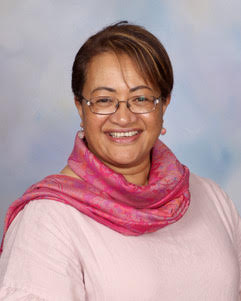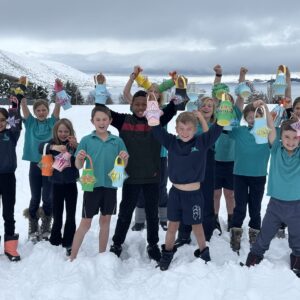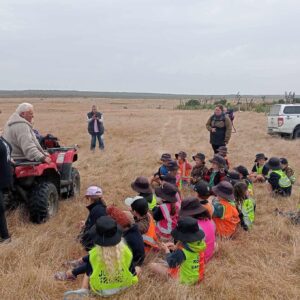A while back, Cherylene Neels figured she had faced just about every challenge available to a new principal. In her first six months, she’d dealt with the fallout from having a statutory manager on site. She had navigated staffing issues and ongoing property hitches, had E. coli in the school’s water supply and been plagued by internet and phone outages.
“I jokingly said to a mentor that the only challenge left to face was a tsunami,” says Neels. “Two weeks later, this other force of nature hit us.”
Neels is talking, of course, about Covid-19.
“Two days before lockdown we’d had ERO [Education Review Office] in the school,” says Neels. “Now we were heading into something completely new. I took a deep breath and decided to take it step by step.”
Neels is principal at Tomarata School in the Rodney district. It is a small school in a farming community and in her short time there, Neels has got to know her staff and community reasonably well. This was helped when, in the first months of 2020, the school undertook a re-visioning and re-valuing exercise.
“We had really good engagement and it helped to pull our school and community together,” says Neels. “Good systems of communication grew from it and that’s been important over the past couple of months.”

One hundred kilometres south, in Panmure, Allison Hamilton has undergone her own introduction to the work of a principal. Ruapotaka School is located in the Tamaki Regeneration zone, where 50 homes are being replaced. The removal of houses and the slow rebuild, has had a major impact on the community and Ruapotaka School.
“The building of new homes has been so slow that families have simply had to go elsewhere,” says Hamilton. “Our roll has dropped and much of the community has become displaced.”
Nevertheless, 16 months in the job have enabled the new principal to get to know her families and the school staff who work alongside her.
“We had established good relationships within our staff and refined our systems and structures. So, when the disruption of Covid came, I was probably in a better position than some other new principals.”
However, in spite of being on top of things, Hamilton found the rapid move from Alert Level 2 to full lockdown “manic”.
“We took all the measures we would usually take at the end of term, but with extra care because we had no idea when we could come back,” she says. “But what made it particularly difficult was that we had major construction going on at the same time and we had to wait until the contractors had locked down safely, the day we were going into full lockdown. Finally, at 9pm, three hours from the start of Level 4, we had to tell the remaining sub-contractors to leave.”
“What made it particularly difficult was that we had major construction going on at the same time and we had to wait until the contractors had locked down safely.”
It was in lockdown that Hamilton began to experience the stresses that have dogged many of her principal colleagues. Foremost in her mind was the wellbeing of her staff.
“I wanted to keep contact with them and monitor how they were doing,” says Hamilton, who has a number of older staff, as well as some living with compromised whānau.
“Then, as we moved toward the beginning of the official new term and provision of home learning, we had to make sure our teachers knew what was happening and what the new normal would look like.”
It was particularly difficult for Hamilton because, even when the country moved to Level 3, her senior leaders were unable to fully engage because of compromised immunity, or living with someone with compromised immunity. This meant that Hamilton had to make decisions and then do much of the implementation on her own.
The experience of Katie Pennicott, a new principal at Sunnyvale Primary School in West Auckland, had some similarities.
There had been a scramble to prepare for lockdown, involving principal-led PLD in the use of Google Classroom and the distribution of 200 devices to families in preparation for distance learning.
But once the school was secured, things became really hard for the principal. Pennicott spent each day checking in with individual teachers, being mindful of each person’s unique circumstance. She offered support and advice, and then, as time went by, added a professional focus, in preparation for distance teaching.
At the same time, Pennicott was contacting parents, enquiring after their wellbeing and informing them, as best she could, about what was likely to happen once the new school term began.
“I was frantically busy, but I thought it was critical to keep our school community connected … Whanaungatanga is one of our school’s core values and we needed to embody that.”
“I was frantically busy, but I thought it was critical to keep our school community connected,” says Pennicott. “That was what would get people through. Whanaungatanga is one of our school’s core values and we needed to embody that.”
It was exhausting, especially because keeping everyone informed meant reading and summarising ongoing communications from the Ministry of Education and other sources.

Neels and Hamilton also found the torrent of information overwhelming.
“It wasn’t just the multi-page emails from the Ministry,” says Neels. “There was also advice from NZPF [New Zealand Principals’ Federation] and NZEI Te Riu Roa. Picking out what was relevant to my context was so time-consuming.”
Luckily for Neels, her First Time Principals (FTP) Programme mentor recognised this need and began to send out summaries of the information. These were shared on the regular Zoom meetings of the local principals’ group, which agreed on common messaging that was shared with the local community.
Support from outside the school has been critical to Neels. Aside from her FTP mentor, she has been in regular phone contact with the principal from her previous school.
“We’ve spoken almost every day,” says Neels. “Without the quality support I’ve received, this would have been an even more daunting event.”
“Without the quality support I’ve received, this would have been an even more daunting event.”
In Panmure, Hamilton is also grateful for the support of others. She belongs to a number of principal groups.
“That’s where I’ve turned to get ideas on how to deal with issues. Often people have shared approaches that hadn’t occurred to me. They might be working in a very different context, but with a few small changes I could apply it to my own.”
Hamilton has found shared health and safety protocols invaluable. Notices to parents, prepared by another principal, were adapted and distributed in the rush to lockdown.
“The New Zealand Principals’ Facebook group has been fantastic too,” she says. “I couldn’t have managed without it.”

Rising to the occasion
Providing at-home and online learning for students was a challenge for all three principals, but there were also many positive spinoffs.
At Tomarata School, a digital platform had only just been introduced. Many staff, especially some of the older teachers, were still coming to terms with Seesaw when distance teaching became a priority.
“It was really tough for them,” says Neels. “Even arranging Zoom or Google hangouts for staff meetings was a struggle. However, I’m proud to say everyone rose to the occasion and there was a lot of very successful distance teaching and learning that went on. I think part of the reason for that was that we tried to keep everything fun and reduce the stresses. The high levels of engagement we had suggests we got that right.”
In Sunnyvale, the rollout saw principal Pennicott spending long nights talking parents through the set-up of devices and the accessing of learning.
The school’s focus on whanaungatanga shaped the online teaching and learning.
“I wanted the children’s online experience to be about connection; not just student-to-teacher, but student-to-student,” says Pennicott. “We didn’t send our students off to use a variety of apps. Instead we made one space, where they could interact. Google Classroom became the place to share and connect with each other. It worked really well.”
Meeting family expectations around home learning was sometimes problematic however. Pennicott relates how media reports caused parents to expect the delivery of packs and devices quickly and universally.
“We copped the flack when that didn’t happen,”says Pennicott. “We could have done without that. Actually, media reporting was an ongoing problem. The information being published was frequently different from what we were being told by the Ministry. That made my job harder.”
“Media reporting was an ongoing problem. The information being published was frequently different from what we were being told by the Ministry. That made my job harder.”
While there were many new issues to deal with, old problems did not go away. Property issues continued to take up the time of all three principals, each of whom have building projects at their schools.
Meanwhile that perennial problem, payroll, continued under lockdown. With office staff away for much of the time, it fell to principals to deal with Novopay when there were inevitable errors in staff pay.
“Being underpaid just added to people’s stress levels,” says Pennicott. “It added to mine as well.”
Heading back into the new normal
Returning to Level 2 and the opening of school to students has been a relief to each of the principals. The work that they and their staff have done in the lead-up to this has been great preparation.
“Most staff were back in school before the return [of students], setting up rooms and discussing how to make things run efficiently and safely,” says Hamilton. “There’s a real sharing of responsibility and a buy-in. I think this whole business has had a positive team-building effect.”
At Sunnyvale they were ready to go as well. The successful distance teaching experience and the practical expressions of whanaungatanga over lockdown have built a new resilience and unity of purpose.
“I’m so proud of how my staff have got through this,” says Pennicott.
Neels also talks about resilience. “To get through, we’ve had to work as a team. Without the mindset of caring and sharing and working together, getting through this would have been much more difficult,” says Neels.
“To get through, we’ve had to work as a team. Without the mindset of caring and sharing and working together, getting through this would have been much more difficult.”
“It won’t all be plain-sailing now that we are back,” she concedes. “There will be some trauma in our students and dealing with that will be our priority over the next while.”
Stress and trauma will be a focus for each of the principals as they go forward.
Asked what they have learned from the past couple of months, they agree there has been plenty. Each has developed a deeper understanding of their school and community.
“Schools aren’t just a principal, some teachers and students,” says Neels. “They are part of a whole community and we have to be aware of what the community wants for its young people.”
All three principals have learned to reach out for support and information before making a decision, but also to trust in their own judgement.
“Years ago, a principal told me that being in charge of a school can be a very lonely job,” says Hamilton. “I’ve certainly felt that, but I have also appreciated being part of a group of peers. I’ve also learned not to compare myself and my situation with others.”
“I’ve learned to back myself to make an informed decision.”
Pennicott’s belief in her staff has been matched by her now-greater self-belief. “I’ve learned to back myself to make an informed decision,” she says. “Get the information, try to do the best you can for everybody, and don’t second-guess.”
“It’s okay to make a mistake,” says Neels. “I’ve learned that. The worst thing I could have done was sit in my office and be overwhelmed. Instead, I got on the phone, asked some questions and made a decision. Then I pulled up my big-girl pants, took a deep breath and got on with it.”



